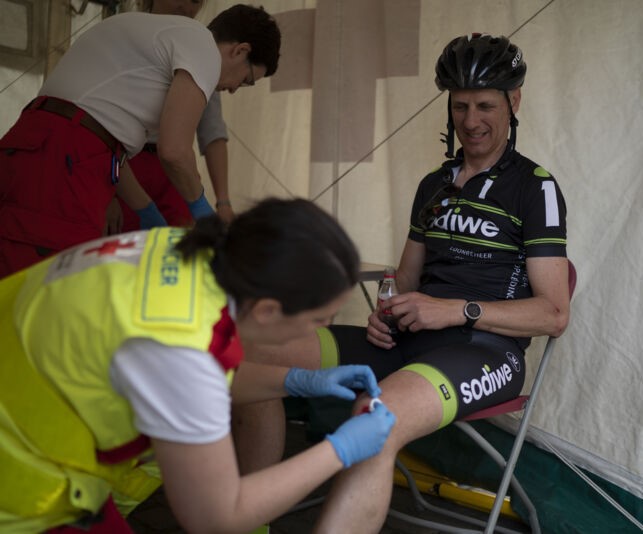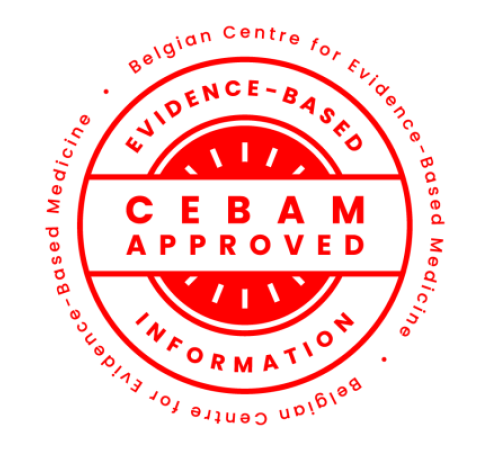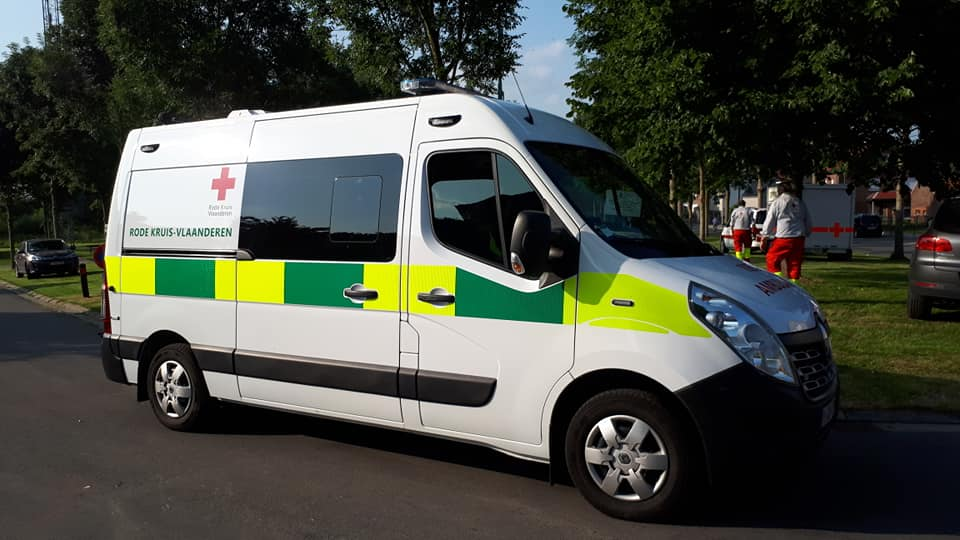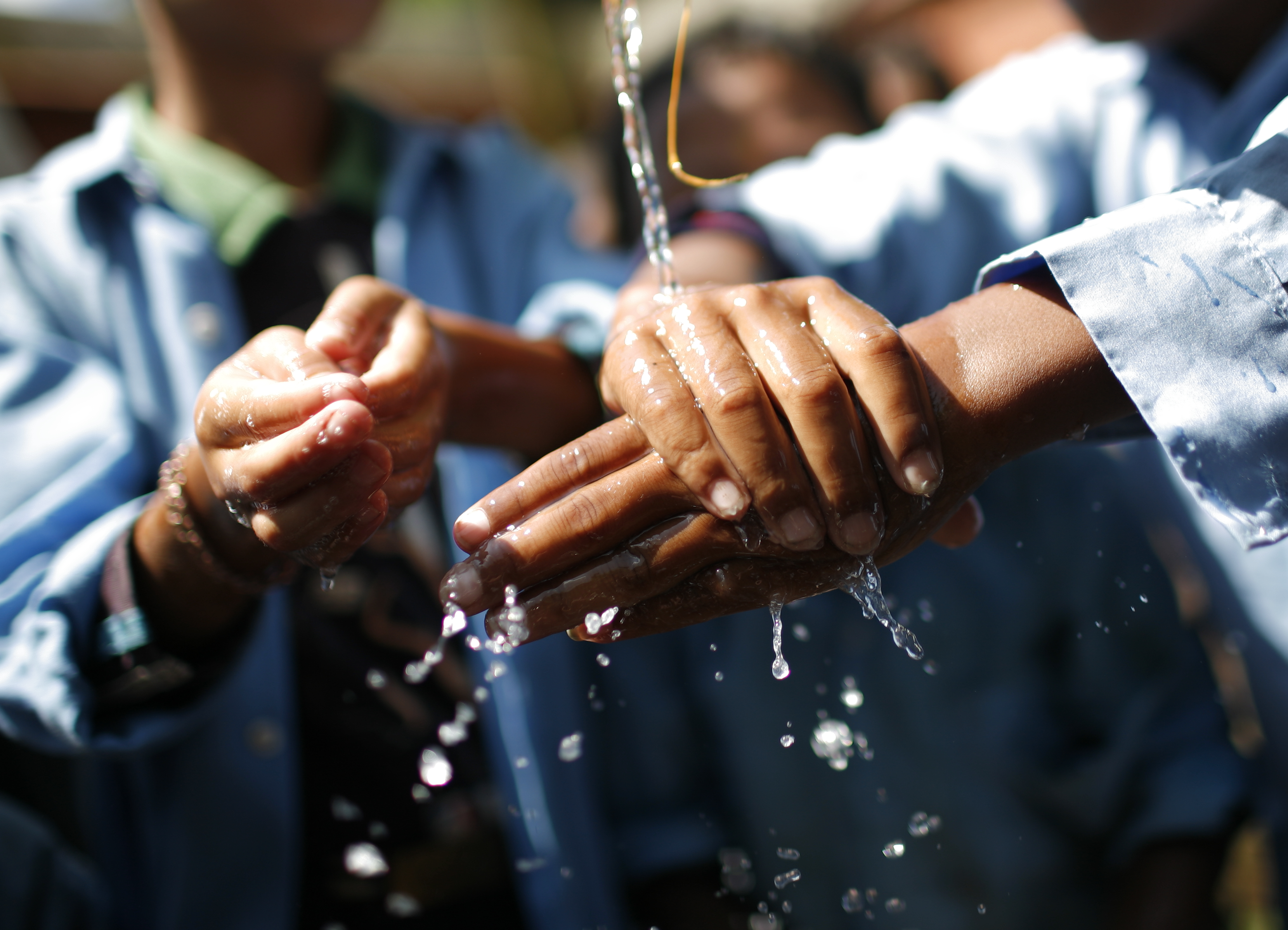2022
First aid
Update of the first aid manual for first responders
 In addition to the manual 'Help! First aid for everyone', Belgian Red Cross has a manual titled 'Help! First aid for first responders'. This manual contains advanced first aid recommendations to train our Relief Service volunteers who occupy preventive first aid posts at a variety of manifestations, and provide relief in the aftermath of disasters.
In addition to the manual 'Help! First aid for everyone', Belgian Red Cross has a manual titled 'Help! First aid for first responders'. This manual contains advanced first aid recommendations to train our Relief Service volunteers who occupy preventive first aid posts at a variety of manifestations, and provide relief in the aftermath of disasters.
In updating this manual, CEBaP used 57 existing evidence summaries from previously developed up-to-date guidelines (i.e. the 2019 First Aid for First Responders in Africa guideline and the 2021 European Resuscitation Council guidelines that are informed by the 2020 CoSTR published by ILCOR). We also updated 3 existing evidence summaries and developed 8 new evidence summaries. The evidence was translated into practical recommendations and discussed with a panel of experts. The manual will be finalized by the summer of 2023.
First aid for road safety in Africa
 The International Cooperations Department of Belgian Red Cross is developing a training and short booklet on first aid for road safety in Africa. Together with CEBaP, they organized a virtual meeting in July with an expert panel, consisting of academics and first aid instructors from several Red Cross and Red Crescent National Societies in Africa. The goal of this first meeting was to reach consensus on the content of the training and to define research questions regarding the prevention, diagnosis, and management of certain road traffic injuries.
The International Cooperations Department of Belgian Red Cross is developing a training and short booklet on first aid for road safety in Africa. Together with CEBaP, they organized a virtual meeting in July with an expert panel, consisting of academics and first aid instructors from several Red Cross and Red Crescent National Societies in Africa. The goal of this first meeting was to reach consensus on the content of the training and to define research questions regarding the prevention, diagnosis, and management of certain road traffic injuries.
After this meeting, CEBaP conducted systematic literature searches for a total of 10 research questions and summarized the characteristics, findings, and certainty of the identified evidence. The International Cooperations Department translated the evidence into practical recommendations that were discussed during a second meeting in February 2023 in Kigali, Rwanda. This project is part of a broader PhD project on first aid education in Sub-Saharan Africa, conducted by CEBaP’s junior researcher Irvin Kendall.
Systematic review on the effectiveness of first aid training for laypeople
 First aid is an essential component of the prehospital care system, which encompasses the care provided by the community before arrival at a formal healthcare facility. Prehospital care plays an important role in preserving life, preventing further harm, and promoting recovery of ill and injured persons. Providing appropriate, high-quality first aid is therefore a concern of first aid guideline developers, first aid training organizers, and public health policy-makers worldwide. However, an up-to-date comprehensive systematic review on the effectiveness of first aid training for laypeople is currently lacking. A priority exercise by Cochrane First Aid revealed this topic as a high priority for a systematic review.
First aid is an essential component of the prehospital care system, which encompasses the care provided by the community before arrival at a formal healthcare facility. Prehospital care plays an important role in preserving life, preventing further harm, and promoting recovery of ill and injured persons. Providing appropriate, high-quality first aid is therefore a concern of first aid guideline developers, first aid training organizers, and public health policy-makers worldwide. However, an up-to-date comprehensive systematic review on the effectiveness of first aid training for laypeople is currently lacking. A priority exercise by Cochrane First Aid revealed this topic as a high priority for a systematic review.
Therefore, CEBaP started conducting a Cochrane review on the effects of first aid training for laypeople on (1) the helping behavior of the persons providing first aid, (2) the quality of the first aid provided, and (3) the health outcomes of the people receiving first aid. The protocol for this review was published recently in The Cochrane Library.
Study on first aid blended learning in Rwanda
In 2019, the International Cooperations Department of Belgian Red Cross has developed a blended learning approach to organise first aid trainings for partner National Societies. In this approach, participants first complete a theory course via a mobile application, and next attend a 1-day in-person training that is focused on practicing first aid skills.
In order to investigate the impact of this blended learning approach on helping behavior and first aid-related learning outcomes (knowledge, skills, self-efficacy, willingness to help), CEBaP designed a randomized controlled trial comparing blended learning training to face-to-face training or no first aid training. In December 2022, Rwanda Red Cross, the International Cooperations Department and CEBaP conducted a pilot study including 72 training participants. The different outcomes were measured before and after the first aid trainings. A follow-up measurement is planned in June 2023, 6 months after the training. The data from the first part of the pilot study are currently being processed and the results will be used to optimize the protocol for the actual study, which will take place from August 2023 to February 2024.

Validation of the first aid manual for laypeople

In 2021, Belgian Red Cross published its updated evidence-based first aid manual for laypeople, titled ‘Help! First aid for everyone’. In updating this manual, we followed the rigorous methodology of the AGREE II instrument, which is the current gold standard used for guideline development.
Just like in 2017, we submitted this updated guideline for validation by the Belgian Centre for Evidence-Based Medicine (Cebam), an independent scientific institute that assesses the methodological quality of clinical practice guidelines in Belgium. After going through the validation process, we obtained the renewal of our certificate of “high-quality evidence-based guideline”. The partial guideline, covering 6 first aid themes, can be consulted here (content in Dutch).
Disaster preparedness and ambulance services
Towards evidence-based provision of preventive aid at mass gatherings
 Each year, Belgian Red Cross volunteers provide preventive medical aid at more than 8000 events, such as music festivals, sports events or city festivals. Adequate on-site first aid delivery is one of the cornerstones of ensuring a safe event. Together with Belgian Red Cross Relief Service, CEBaP researchers have been working on a tool to scientifically underpin pre-event planning and resource provision at these events. We analyzed the data captured in our in-house MedTRIS (Medical Triage and Registration Informatics System) database to identify factors that are associated with higher medical usage rates at mass gatherings.
Each year, Belgian Red Cross volunteers provide preventive medical aid at more than 8000 events, such as music festivals, sports events or city festivals. Adequate on-site first aid delivery is one of the cornerstones of ensuring a safe event. Together with Belgian Red Cross Relief Service, CEBaP researchers have been working on a tool to scientifically underpin pre-event planning and resource provision at these events. We analyzed the data captured in our in-house MedTRIS (Medical Triage and Registration Informatics System) database to identify factors that are associated with higher medical usage rates at mass gatherings.
Two peer-reviewed papers regarding these analyses were published in 2022.
In a first descriptive study published in the Emergency Medicine Journal, we showed that medical usage rates, frequency of triage categories and type of injury or medical complaint varied substantially across mass gathering categories.
In a second study, we developed and validated a prediction model of patient presentation rate (PPR) and transfer to hospital rate. The results of this analysis were published in BMC Public Health and presented to more than 500 Belgian Red Cross volunteers during the Symposium for Medical Disaster Management, an event organized by Belgian Red Cross provincial chapter West-Flanders.
Pilot project non-emergency ambulance transport: data analysis
 From May to November 2022, the Relief Service of Belgian Red Cross conducted a pilot project to explore the need for and the feasibility of non-emergency ambulance transport during weeknights and weekends in the West-Flanders province.
From May to November 2022, the Relief Service of Belgian Red Cross conducted a pilot project to explore the need for and the feasibility of non-emergency ambulance transport during weeknights and weekends in the West-Flanders province.
During the 6-month pilot period, volunteers collected data on the timing, location, and kilometers of each ambulance ride, and on the availability of volunteers and ambulances. These data were analyzed and visualized by CEBaP. The results show a demand for non-emergency ambulance transport during weeknights and weekends, and an effective response by our trained volunteers.
Blood donation and transfusion
Scoping review on blood banking in Africa
With the ultimate aim of optimizing the operation of African blood banks and obtaining a sustainable population of voluntary blood donors, we mapped the existing evidence (gaps) concerning blood banking in Africa. Studies on the following topics were included: blood safety, blood supply after a (natural) disaster, donor recruitment and maintenance, and blood storage and processing. A total of 266 research papers were included, most of which concerned blood safety (75%) or donor recruitment and maintenance (20%). The majority of studies (93%) were cross-sectional, and therefore did not allow to establish causal relationships between measured variables. Controlled research regarding blood banking in African countries is scarce, highlighting the need for future research within this context.
Updated systematic review on blood donation by men who have sex with men
In 2015, CEBaP published a systematic review that included 14 papers on the risk of transfusion-transmissible infections (TTIs) in male blood donors who had sex with another man (MSM). In 2022, we updated the review and included 11 additional papers. We concluded that male blood donors reporting sex with men may be at increased risk of TTIs, and HIV specifically. Moving from permanent deferral of men who have sex with men to a 1-year deferral period may have little to no impact on overall infection risk in blood donors. However, all evidence is of very low certainty. In addition, there is insufficient evidence on the impact of shorter or risk-based deferral policies, and on differences in risk behaviour among MSM donors. The paper is currently under peer review.
Systematic review on the safety of preoperative iron and/or ESA therapy
At the 2018 International Consensus Conference on Patient Blood Management, preoperative supplementation with iron and administration of erythropoiesis-stimulating agent (ESA) were recommended to reduce red blood cell transfusion rates in adult patients with anemia undergoing scheduled surgery. However, at that time, little was known about the safety of these therapies. A grant from the European Blood Alliance allowed us to conduct a systematic review investigating the occurrence of adverse events during or after treatment with iron and/or ESAs.
Data from 26 randomized controlled trials and 16 cohort studies on 6 treatment comparisons across 15 adverse event categories were extracted. Most data concerned mortality/survival, and thromboembolic, infectious, cardiovascular and gastrointestinal adverse events. The certainty of evidence was very low in all but one outcome category, meaning that it remains unclear whether ESA and/or iron therapy are associated with adverse events in preoperatively anemic elective surgery patients. This uncertainty resulted from both the low quantity and quality of adverse event data due to limitations in data collection, measurement and reporting. The full paper was published in Systematic Reviews.
Best available evidence on blood transfusion of neonates and infants
Neonatal intensive care, particularly for very low birth weight infants, is characterized by frequent red blood cell (RBC) transfusions. Although selecting the safest possible type of RBC concentrate is of paramount importance to prevent adverse events, such as heart arrythmia, rupturing of the cells, transfusion-transmitted infection, or even death during or after transfusion, little scientific evidence is available to support the use of specific selection criteria.
The Blood Service of Belgian Red Cross therefore asked CEBaP to produce 7 evidence summaries that would provide insight into the usefulness of certain selection criteria for RBC concentrates that are given to neonates and infants in need of (massive) transfusion. The focus was on the selection of RBC concentrates that undergo additional treatments (such as removal of white blood cells, cytomegalovirus serology or irradiation), are stored for a shorter period of time, or have certain properties (such as the absence of high-titer anti-A and anti-B blood group antibodies). In 5 of the 7 summaries, no relevant studies could be identified, highlighting the need for additional high-quality research. The other 2 summaries identified limited evidence neither in favor of transfusing neonates with fresh RBCs nor with older RBCs (low-certainty evidence), and limited evidence in favor of transfusing pregnant women with extended antigen-matched RBCs (very low-certainty evidence).

Humanitarian aid and development
Effectiveness of WASH behaviour change interventions in rural Tanzania
 From 2018 through 2021, Tanzania Red Cross Society and the International Department of Belgian Red Cross conducted a cluster randomized controlled trial to evaluate the effectiveness of supplementing a standard package of ‘Water, Sanitation, and Hygiene’ (WASH) interventions with various behavior change interventions in rural Tanzania. In one group, information was first collected on the factors that trigger behavior change in that particular population, and then the supplementary intervention was adjusted accordingly (‘contextualized supplementary intervention’). A second group received a pre-defined supplementary intervention, only focusing on one specific factor of behavior change (‘non-contextualized supplementary intervention’). A third group received only the standard package of WASH interventions, consisting of infrastructure improvements and a set of standard educational sessions. The study protocol can be found here.
From 2018 through 2021, Tanzania Red Cross Society and the International Department of Belgian Red Cross conducted a cluster randomized controlled trial to evaluate the effectiveness of supplementing a standard package of ‘Water, Sanitation, and Hygiene’ (WASH) interventions with various behavior change interventions in rural Tanzania. In one group, information was first collected on the factors that trigger behavior change in that particular population, and then the supplementary intervention was adjusted accordingly (‘contextualized supplementary intervention’). A second group received a pre-defined supplementary intervention, only focusing on one specific factor of behavior change (‘non-contextualized supplementary intervention’). A third group received only the standard package of WASH interventions, consisting of infrastructure improvements and a set of standard educational sessions. The study protocol can be found here.
In 2022, CEBaP analyzed the data and concluded that all interventions (the standard package and the add-on behavior change interventions) resulted in increases of hand-washing behaviour (immediately after and one year after the interventions), WASH infrastructure (immediately after and one year after the interventions) and latrine use (only immediately after the interventions), but not on health outcomes such as diarrhoea. In addition, an added value of the two add-on interventions was found on hand-washing behaviour (none of them being superior), but not on WASH infrastructure, latrine use and diarrhoea. Detailed results can be found in this report.
